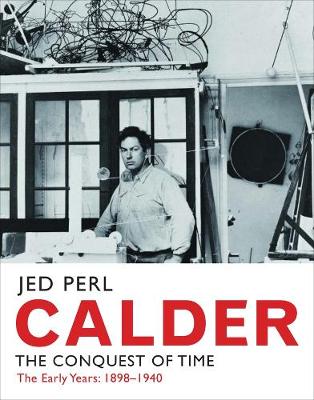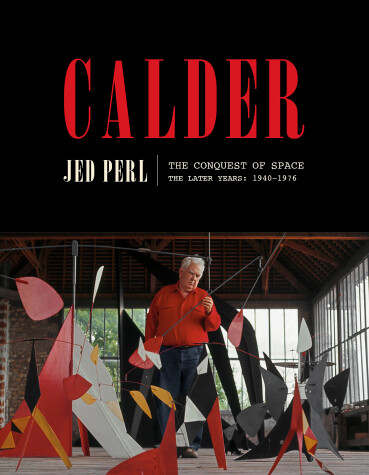A Life of Calder
2 primary works
Book 1
The first biography of America's greatest twentieth-century sculptor. In this beautifully written, deeply researched book Jed Perl shows how Alexander Calder became an avant-garde artist with enduring appeal.
One of our most beloved modern artists, Calder is celebrated above all as the inventor of the mobile. Only now is the full story of his life being told in a gloriously illustrated biography, which features unseen photographs and is based on scores of interviews and unprecedented access to Calder's papers.
Born into a family of artists, Calder forged important friendships with a who's who of twentieth-century creators, including Georges Braque, Marcel Duchamp, Martha Graham, Joan Miró, Piet Mondrian and Virgil Thomson. His early years studying engineering were followed by artistic triumphs in Paris in the late 1920s, and his emergence as a leader in the international abstract avant-garde.
His marriage in 1931 to Louisa James—a great-niece of Henry James—is a richly romantic story. This transatlantic life carries readers from New York's Greenwich Village, to the Left Bank of Paris during the Depression, and then to a refugee-filled London just before the War, where Calder's circle of friends included Barbara Hepworth, Ben Nicholson and Kenneth Clark.
One of our most beloved modern artists, Calder is celebrated above all as the inventor of the mobile. Only now is the full story of his life being told in a gloriously illustrated biography, which features unseen photographs and is based on scores of interviews and unprecedented access to Calder's papers.
Born into a family of artists, Calder forged important friendships with a who's who of twentieth-century creators, including Georges Braque, Marcel Duchamp, Martha Graham, Joan Miró, Piet Mondrian and Virgil Thomson. His early years studying engineering were followed by artistic triumphs in Paris in the late 1920s, and his emergence as a leader in the international abstract avant-garde.
His marriage in 1931 to Louisa James—a great-niece of Henry James—is a richly romantic story. This transatlantic life carries readers from New York's Greenwich Village, to the Left Bank of Paris during the Depression, and then to a refugee-filled London just before the War, where Calder's circle of friends included Barbara Hepworth, Ben Nicholson and Kenneth Clark.
Book 2
The concluding volume to the first biography of one of the most important, influential, and beloved twentieth-century sculptors, and one of the greatest artists in the cultural history of America--is a vividly written, illuminating account of his triumphant later years.
The second and final volume of this magnificent biography begins during World War II, when Calder--known to all as Sandy--and his wife, Louisa, opened their home to a stream of artists and writers in exile from Europe. In the postwar decades, they divided their time between the United States and France, as Calder made his first monumental public sculptures and received blockbuster commissions that included Expo '67 in Montreal and the 1968 Olympics in Mexico City. Jed Perl makes clear how Calder's radical sculptural imagination shaped the minimalist and kinetic art movements that emerged in the 1960s. And we see, as well, that through everything--their ever-expanding friendships with artists and writers of all stripes; working to end the war in Vietnam; hosting riotous dance parties at their Connecticut home; seeing the "mobile," Calder's essential artistic invention, find its way into Webster's dictionary--Calder and Louisa remained the risk-taking, singularly bohemian couple they had been since first meeting at the end of the Roaring Twenties. The biography ends with Calder's death in 1976 at the age of seventy-eight--only weeks after an encyclopedic retrospective of his work opened at the Whitney Museum in New York--but leaves us with a new, clearer understanding of his legacy, both as an artist and a man.
The second and final volume of this magnificent biography begins during World War II, when Calder--known to all as Sandy--and his wife, Louisa, opened their home to a stream of artists and writers in exile from Europe. In the postwar decades, they divided their time between the United States and France, as Calder made his first monumental public sculptures and received blockbuster commissions that included Expo '67 in Montreal and the 1968 Olympics in Mexico City. Jed Perl makes clear how Calder's radical sculptural imagination shaped the minimalist and kinetic art movements that emerged in the 1960s. And we see, as well, that through everything--their ever-expanding friendships with artists and writers of all stripes; working to end the war in Vietnam; hosting riotous dance parties at their Connecticut home; seeing the "mobile," Calder's essential artistic invention, find its way into Webster's dictionary--Calder and Louisa remained the risk-taking, singularly bohemian couple they had been since first meeting at the end of the Roaring Twenties. The biography ends with Calder's death in 1976 at the age of seventy-eight--only weeks after an encyclopedic retrospective of his work opened at the Whitney Museum in New York--but leaves us with a new, clearer understanding of his legacy, both as an artist and a man.

